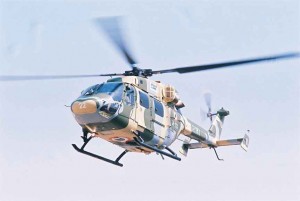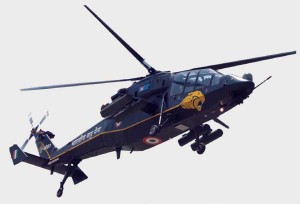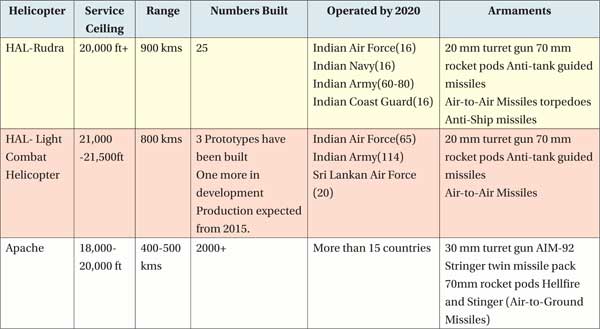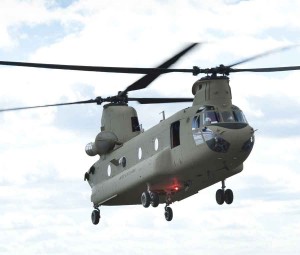Established in 1986, the Army Aviation Corps (AAC) is one of the youngest Corps in the Indian Army. It has operated over all types of terrain from deserts plains, forests and high mountains to perpetually frozen battlefields. Army aviators fly several missions everyday to support forces deployed in high altitude areas. Some of the missions are dedicated to casualty evacuation and routine operations for the AAC. Day in and day out, the AAC also perform a wide range of tasks such as ferrying soldiers to and from the battlefield. Army aviators thus work as a force multiplier by providing rapid movement of men and material at short notice. The AAC has taken part in a number of UN missions and several disaster relief operations in India.
Since its formation, the AAC continues to remain primarily a reconnaissance and observation force…
Established in 1986, the Army Aviation Corps (AAC) is one of the youngest Corps in the Indian Army. It has operated over all types of terrain from deserts plains, forests and high mountains to perpetually frozen battlefields. Army aviators fly several missions everyday to support forces deployed in high altitude areas. Some of the missions are dedicated to casualty evacuation and routine operations for the AAC. Day in and day out, the AAC also perform a wide range of tasks such as ferrying soldiers to and from the battlefield. Army aviators thus work as a force multiplier by providing rapid movement of men and material at short notice. The AAC has taken part in a number of UN missions and several disaster relief operations in India.
Despite the fact that 24 years have gone by since its formation after breaking away from the Indian Air Force (IAF), the AAC continues to remain primarily a reconnaissance and observation force. The induction of the Rudra helicopter appears to be the sole saving grace. To begin with, the AAC needs to replace its 190-odd fleet of ‘Cheetah’ and ‘Chetak’ helicopters that are of 1970s vintage and form the bulk of their rotary wing fleet.
The AAC performs a crucial role both in war and peace time operations. However, with the changing battlefield scenario, more and more air elements are being added to the inventory of land forces all over the world and the Tactical Battle Area will present an entirely different picture in future warfare. The Indian Army requires flexibility and swift action to challenge the enemy forces. With the crucial elements of firepower, reconnaissance, observation and transportation, the Aviation Arm of the Indian Army will be a formidable force with sufficient firepower assets in its inventory. Further, it would be more flexible and effective for Counter Surface Force Operation (CSFO), destruction of enemy air defence assets, tactical transport, Counter-Insurgency Operations (COIN), offensive employment in urban warfare, Search And Rescue (SAR) operations, battlefield support, High Altitude Warfare (HAW), anti-tank role and scout duties.
The Indian Army today needs a sizeable fleet of attack helicopters…
The AAC will have an integral Aviation Brigade, which will have a squadron each of utility, armed and reconnaissance helicopters. Future acquisitions of Light Utility Helicopters (LUH), light attack, Armed Helicopters (AH) and heavy-lift helicopters will greatly enhance the capability of the Indian Army and will be a game changer in any future conflict.
Light Attack and Armed Helicopter Fleet
In keeping with the changing paradigms of modern warfare which has brought out the need for a fleet of attack helicopters as an integral component of assembled firepower, the Indian Army today needs a sizeable fleet of attack helicopters. The Long Term Perspective Plan (LTPP) of the AAC includes the requirement of a combined arm team which would help it to operate across the full spectrum of operations. These assets would be needed for fire support and direct attack roles in support of ground forces. An integrated attack helicopter element will mean better synergy with ground forces in attack.
There is an acute shortage of attack helicopters in the Indian Armed Forces particularly those that have the capability to operate at high altitudes. In this respect, indigenous attack helicopters have enhanced the firepower of the Aviation arm of the Indian armed forces.
The AAC inducted in 2001 the first – Advanced Light Helicopter (ALH) Dhruv manufactured by Hindustan Aeronautics Limited (HAL). Since then, this fleet has grown rapidly and is already on the path to becoming the mainstay of the AAC for day and night operations. The weaponised version of the ALH Weapon Systems Integrated (WSI) also known as the Rudra Mk IV, is the first armed helicopter being produced indigenously and has already been inducted into the AAC in 2013. The Indian Army plans to equip the AAC with 80 Rudra helicopters to form eight squadrons.
HAL is also working on an indigenous attack helicopter called the Light Combat Helicopter (LCH). With the LCH, the ability of the Indian armed forces to take on both the hostile neighbours on the icy Himalayan heights will be considerably enhanced. The Indian Army has ordered 114 LCHs from HAL. Production of these is expected to commence in 2015.
The IAF is set to receive 15 heavy lift Chinook (CH-47F) helicopters…
Both the helicopters are specialised for high altitude warfare and have enormous firepower which makes them effective and efficient. They can be utilised in a wide range of operations such as reconnaissance, troop transport, anti-tank warfare and close air support. They can also take on enemy targets in a battlefield scenario alongside tanks and artillery.
Both the helicopters have all the capabilities which modern day attack helicopters should have. Indigenously producing these state-of-the-art war machines puts India in the select club of countries that can produce sophisticated attack helicopters on their own. The capabilities of these helicopters are on a par with helicopters produced as per world class standards. This gives India a commercial as well as strategic opportunity to export these machines.
Recently, after a long tussle between the Indian Army and the IAF, the Ministry of Defence (MoD) decided that future acquisitions of attack helicopters would be for the Indian Army. The MoD was of the view that attack helicopter would be more meaningful for ground forces and rightfully, the Indian Army must have control over the attack helicopter fleet. The Indian Army can now have its own unit of the Apache attack helicopters. Recent reports indicate that the government has approved four squadrons of the iconic Apache attack helicopters for the Indian Army and the first batch of these machines is expected to be inducted in 2018. The initial batch, which is meant to replace the IAF’s ageing fleet of Soviet-era helicopters, will be armed with Hellfire and Stinger missiles. 39 more are on order for the Indian Army and will be deployed as part of a new Mountain Division which is being raised for operations along the disputed borders with China.
Light Utility/Observation Helicopter Fleet
The Indian Armed Forces have a requirement for 384 helicopters for Reconnaissance and Surveillance role to replace the ageing fleet of Cheetah and Chetak helicopters. India plans to buy 187 single engine indigenously-designed Light Utility Helicopter (LUH) and would import 197 LUH helicopters from a foreign vendor. However, as per media reports, plans to procure 197 choppers from abroad has been cancelled. HAL has now been tasked to produce around 400 LUH for the three services.
The AAC today has a requirement of about 200 LUHs. The first flight of the indigenous LUH is expected in 2015. Production is planned to begin thereafter in 2015 with ten helicopters being produced per year. The rate of production would be scaled up to 36 helicopters per year. Delivery of 187 LUHs by HAL is to be completed by 2022. LUHs are supposed to undertake patrol, casualty evacuation and reconnaissance roles mainly in high altitude areas of 20,000 to 23,000 feet and would be effectively used as Tactical Battle Support Helicopters.
Medium Multi Role Helicopters
The helicopters of the future may not fit comfortably into the age-old specific categories of reconnaissance, attack, utility and cargo. Future helicopters would be multi-role, offering diverse capabilities, flexible options and significant cost savings. In order to fulfill the manifold tasks, the Indian Army also has evinced interest in the Indian Multi-Role Helicopter (IMRH) being developed by HAL and is keen to induct a large number of these helicopters into its Aviation wing in future.
The mission of the AAC is to find, fix and destroy the enemy through fire and maneuver and to provide combat support…
By 2007, the procurement process had already has been “set into motion” for Tactical Battle Support helicopters. These types of helicopters are generally used for troop movement, offshore operations, heli-borne and amphibious assault operations, anti-submarine warfare and anti-surface warfare operations. An armed gunship version is also expected to be developed concurrently. Other proposed variants include civil transport, VVIP transport and air ambulance. HAL has estimated that requirements for the Indian Multi-Role Helicopter will be more than 400 by the armed forces. HAL will also be targeting export orders since more than 5,000 Mi-8/17 variants are operational in more than 40 air forces around the world. Many of these are considering replacing them with newer generation helicopters.
As per sources, HAL has already done preliminary work on the design of the new 10 to 12 tonne helicopter which will be a larger version of the Dhruv. With a ceiling of around 20,000 feet and a 3,500-kg payload capacity, the IMRH will have the capacity to seat 24. Although there had been offers of joint ventures by two companies, these were scrapped as they did not match the requirements of the Indian armed forces. Thus, HAL is considering going it alone in development of the helicopter.
Heavy Lift Helicopters
Transport helicopters can accomplish what a fixed wing aircraft cannot. Heavy lift helicopters have the capability to carry a wide range of materials and troops into the battlefield. With the raising of a new Strike Corps in Arunachal Pradesh and the modernisation of the artillery, heavy lift helicopters are bound to be required by the Indian Army which is going to need its own fleet of heavy lift helicopters to induct men and machines where required. While the IAF is set to receive 15 heavy lift Chinook (CH-47F) helicopters, the Indian Army has requisitioned for its own heavy lift helicopters. The issue is under consideration at the MoD and the final decision is awaited.
The Chinook has served as the backbone of the US Army Air Corps since the Vietnam War. Boeing has delivered more than 1,200 Chinooks to 18 operators around the world since delivering the first to the US Army on August 16, 1962. More than 800 are in operation today in combat, cargo transport and humanitarian relief missions.
The Chinook can carry 55 fully armed troops or 11,100 kg of weight, inside or under-slung. The CH 47F is an all weather rotorcraft, capable of operating exceedingly well at high altitudes.
Neighbourhood Watch
Pakistan Army Aviation Corps
Our historic rival Pakistan has successfully utilised its Army attack helicopters against the Tehrik-e-Taliban Pakistan (TTP), as attack helicopters are best for such situation. Pakistan operates a fleet of Bell AH-1 Cobras. Having received its first ten AH-1S models in 1984, it was to receive another ten in 1986. Due to US sanctions resulting from Pakistan’s nuclear weapons programme, the option for the ten was never exercised. However, when US arms sales resumed in the late 1990s, new C-NITE sensors, 70 mm rockets and TOW missile launchers were delivered bringing Pakistani Cobras up to world-class standards. Additional ex-US Army AH-1Fs were received in the 2000s and Pakistan Army Aviation currently has 34 of the type in service, which has been used against the Taliban in the country’s remote Western region.
Analysts believe that by the year 2025, the Indian AAC which would be advanced in both in number and machine…
In the coming years, Pakistan wishes to replace its Cobra fleet with advanced AH-1Z Vipers. Today, Pakistan’s AAC comprises several attack and utility helicopters in its fleet including about seven to ten transport aircraft, 50 to 60 Cobra attack helicopters and about 250 to 300 utility helicopters. These assets have enhanced its troop transportation, observation and casualty evacuation capabilities with assistance of effective firepower. Since its inception, the Corps has become a significant combatant arm of the Pakistan Army, poised for a definite and critical role in peace or in war.
Chinese Army Aviation Corps
Separated from the People’s Liberation Army Air Force (PLAAF), The People’s Liberation Army (PLA) Aviation Corps is well equipped with attack, transport and other specialised helicopters as well as light fixed-wing aircraft which carry out air maneuvers and provide support to ground operations. The PLA Army Aviation 1st Helicopter Regiment was founded in 1987, with a total of 55 helicopters. The regiment had four flight groups. The first and second flight groups were equipped with transport helicopters – 22 Mi-17 and eight Mi-17 V5. The third and fourth flight groups were equipped with attack helicopters – 25 Z-9WZ.
Since then, the PLA Army helicopter fleet has grown and is now double the size and strength of the Indian Army Aviation wing. According to statistics presented by defence news sites in China, the People’s Liberation Army Air Corps now has five helicopter brigades and five helicopter regiments, equipped with around 600 helicopters including 212 M-17 series, 70 Z-19 “Blackhawk”, 33 Z-8s, 269 Z-9s and 24 Z-10s and 12 Z-19 which are newly developed dedicated AH (reverse engineering of the Apache Attack Helicopter). The PLA also has sufficient number of fixed-wing transport aircraft which includes the Y-7, Y-8 and XTW4.
The mission of the AAC is to find, fix and destroy the enemy through fire and maneuver and to provide combat support…
China, Pakistan and India established their air wings at almost the same time. However, it is felt that Pakistan Army’s Aviation Corps is quantitatively better developed than India’s whereas the PLA’s Aviation Corps is developed in both quantity and quality in contrast to the Indian Army’s Aviation Corps.
Conclusion
The mission of the AAC is to find, fix and destroy the enemy through fire and maneuver and to provide combat support and combat service support in coordinated operations as an integral member of the combined arms team. On a modern battlefield, the AAC, unlike the other members of the combined arms team, has the organic flexibility, versatility, and assets to fulfill a variety of maneuvers like Combat Service (CS), Combat Service Support (CSS), surveillance, reconnaissance roles and functions. Aviation can accomplish each of these roles within the limits of finite assets and capabilities during offensive or defensive operations and also for joint, combined, contingency or Special Operations.
With more and more air elements being added to the inventory of land forces all over the world, the Tactical Battle Area will present an entirely different scenario in future warfare. Army Aviation has become one of the most important components in the changing nature and structure of armies all over the globe.
As the Indian Army prepares to induct and deploy armed helicopters in key formations alongside its borders with Pakistan and China, firepower and maneuverability should be closely integrated with support of ground operations to provide immediate help as and when required. HAL has carried out commendable work in the field of helicopter design and development. As the third largest in the world today, the Indian Army does not possess adequate numbers of helicopters in its fleet. The AAC in the future would need to have more than 300 helicopters and fixed-wing aircraft in its inventory. Indeed, its long-term plans include a flight of five fixed-wing aircraft each for its six regional or operational commands with a sufficient number of both small and large sized UAVs including the recently inducted IAI Heron and Searcher UAVs.
Analysts believe that by the year 2025, the Indian AAC which would be advanced in both in number and machine compared to its rivals, would be listed among the largest Army Air Corps in the world.










awsome research done by Shantanu k bansal i am proud shantanu k bansal
Amazing research done by Shantanu K Bansal
Amazing , gud research work. !
Great research done by the editor, really liked reading this article.!!.